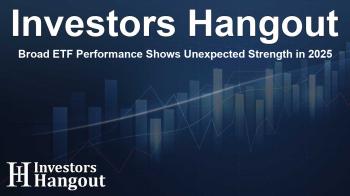Broad ETF Performance Shows Unexpected Strength in 2025

Defying Expectations: ETF Gains in 2025
Amid concerns surrounding the global economy, the start of 2025 has shown a surprisingly positive trend in various major asset classes. Despite the headlines that paint a picture of anxiety, year-to-date results indicate significant gains across the board for exchange-traded funds (ETFs) through the early months of the year.
Leading the Charge: Developed Markets Shine
In the spotlight, stocks in developed markets outside the United States are leading the way with an impressive total return of 20.1%. This remarkable performance has set them apart as the top performers year-to-date. Following closely are global real estate assets outside the US, which have displayed a solid return of 16.1% for the same period, demonstrating the resilience of these markets.
US Markets: A Different Story
Contrasting this strong performance, US assets have lagged behind. American shares have achieved a return of only 6.9%, which pales in comparison to their foreign counterparts. Other segments, including US junk bonds, real estate investment trusts, and investment-grade bonds, are also seeing modest gains, leaving investors to ponder the disparity in performance between domestic and international markets.
A Year Without Defeats
Remarkably, in a year characterized by volatility and uncertainty, it’s notable that there are no outright losers within the ETF landscape. This absence of negative performance metrics suggests that overall optimism remains robust among investors, looking to navigate potential macroeconomic challenges.
Steady Interest Rates Fueling Investor Optimism
One of the significant contributors to this upbeat sentiment is the current stability of interest rates. Although there are ongoing concerns regarding inflation and its potential impacts, the benchmark 10-year Treasury yield has remained within a consistent range. As of yesterday, it settled at 4.44%, which appears to be a comfortable level for most investors, thus fostering a generally positive outlook.
However, analysts caution that should the yield break above the recent high of around 4.60%, it could prompt a reevaluation of investor assumptions regarding future performance, possibly dampening the current enthusiasm.
Investor Expectations on the Rise
A recent survey conducted by a prominent investment management firm indicates that investors have high expectations for long-term returns. On average, US investors foresee returns from stocks at approximately 12.6% per annum, adjusted for inflation. This level of expectation may seem excessively optimistic, especially when reflecting on historical performance.
Managing Expectations: The Need for Caution
It's worth noting that such optimism may be rooted in recent historical trends, which could mislead investors. A forecasting model evaluating US equities suggests a more modest annual growth rate of around 5% over the next decade. This outlook contrasts sharply with the lofty expectations expressed in the Natixis survey.
In revisiting past market performances, investor sentiment often sways heavily, which can lead to unrealistic expectations of future gains. While it’s tempting to believe that “this time is different,” a healthy skepticism is advisable when assessing potential market trajectories.
Conclusion
As we move further into 2025, the landscape for ETFs and major asset classes suggests a surprising resilience even amid macroeconomic uncertainties. With steady interest rates and widespread optimism, it will be essential for investors to remain vigilant and grounded in realistic expectations as the year unfolds.
Frequently Asked Questions
What major asset classes are performing well in 2025?
This year, stocks in developed markets outside the US and global real estate assets are leading the performance with substantial gains.
How do US assets compare to international ones?
US assets are currently lagging with lower returns compared to those in developed markets outside the US.
What factors are contributing to investor optimism?
Steady interest rates and a lack of negative performance among major ETFs are key reasons for the positive sentiment.
What do investors expect for long-term stock returns?
A recent survey indicated that US investors expect long-term stock returns of 12.6% per year above inflation.
Why might investor expectations be overly optimistic?
Expectations are often based on recent performance trends, which might not accurately reflect future outcomes, suggesting the need for cautious optimism.
About The Author
Contact Addison Perry privately here. Or send an email with ATTN: Addison Perry as the subject to contact@investorshangout.com.
About Investors Hangout
Investors Hangout is a leading online stock forum for financial discussion and learning, offering a wide range of free tools and resources. It draws in traders of all levels, who exchange market knowledge, investigate trading tactics, and keep an eye on industry developments in real time. Featuring financial articles, stock message boards, quotes, charts, company profiles, and live news updates. Through cooperative learning and a wealth of informational resources, it helps users from novices creating their first portfolios to experts honing their techniques. Join Investors Hangout today: https://investorshangout.com/
The content of this article is based on factual, publicly available information and does not represent legal, financial, or investment advice. Investors Hangout does not offer financial advice, and the author is not a licensed financial advisor. Consult a qualified advisor before making any financial or investment decisions based on this article. This article should not be considered advice to purchase, sell, or hold any securities or other investments. If any of the material provided here is inaccurate, please contact us for corrections.

